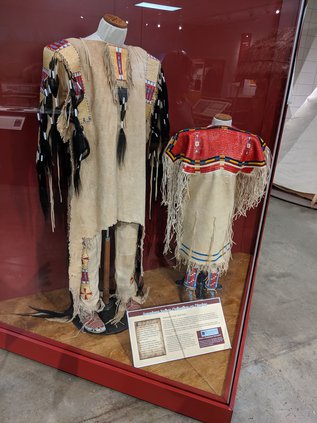LARNED — If it’s been years since your last visit to the Santa Fe Trail Center Museum, it’s time to take another look. For the past few years, volunteers and staff have transformed the once disjointed collection of displays featuring its collection of artifacts from the trail into a walk through history that brings to life the history of trade between the U.S. and Spain in this part of the country. For those familiar only with the basic curriculum of American History offered in high school or college, there are surprises in store.
Beverly Howell, a long-time volunteer and the acting museum director, took time out from assembling the new Native American artifact displays to show the Tribune some of the latest updates.
Essentially, from the moment visitors enter the exhibit wing, they are immersed in the sights of the Santa Fe Trail including a mural that spans the entire north hall depicting an open prairie filled with grasses and wildflowers, and various small prairie animals, and the ruts of wagon wheels from long ago passers-by.
But its the main exhibit space where visitors are introduced to the rigors of prairie life and travel, and the people they might have encountered along that trail during the early and mid-19th century.
Native Americans are a big part of that story, and the museum has worked hard to provide an unsentimental and accurate interpretation of the role they played in the context of trade. And trade is what the Santa Fe Trail was all about, Howell said.
“Our story is civilians, interaction between the three cultures of Native Americans, Mexico and United States, trade, commerce, it was all about commerce,” she said. “That’s what sets the Santa Fe Trail’s story apart from every other trail in this country.”
Displays have been redesigned with a more rustic flavor. Volunteers created enclosures built from branches sawn from local trees and fastened together into rustic fencing in the section that depicts the early days of the trade route. In order to keep the artifacts safe, each branch undergoes a process to insure it will not harbor insects that could damage and destroy artifacts.
First, each branch must be frozen, and remain in deep freeze for 72 hours before it can be removed and allowed to warm back to room temperature. Then, it needs to be coated and sealed three times in polyurethane.
Since the branches are acquired locally, the unseasonably rainy weather has slowed progress on completion of the displays so much, Howell has opted to create temporary displays from cases the museum has on hand so pieces from the Native American collection can be viewed during the Tired Iron Show coming up in October. That’s the museum’s annual festival highlighiting the early settement of Pawnee County. Later this year and early next year, the finishing touches to the permanent Native American displays will be completed, she said.
A war bonnet and other ceremonial items will be central to one of the displays.
In other display cases, visitors can view authentic reproductions of clothing worn by men and women. Look closely and note the difference between early 19th century garments adorned with dyed porcupine quills, compared to later ones featuring application of glass beads Native Americans acquired through trade with Europeans and white settlers from the eastern part of the country. Two of these garments on display were gifted to the museum by the local foundation advocating for people with developmental disabilities, Rosewood Services. This will be the first time they’ve been on display because of previous lack of display space, Howell said.
Another must-see is the fully beaded women’s bodice. This, Howell said, is the “crown jewel” of the collection. The piece has been authenticated by two Native American experts, one, a speaker at last year’s Santa Fe Trail roundup, and the other a noted historian and reenactor. The weight of the beads require the piece to be displayed lying at an angle.
Continue through the museum, and leave the dusty trail and step onto the authentic boardwalk where eventually transport becomes less dominated by horse and wagon, and moreso with train travel. A transitional display at the end of the boardwalk shares how that transition was achieved. This is one of the newest displays, tying together how the trail began and marking its end as one of the countries major trade routes as the railroad era dawned.
The Santa Fe Trail Museum is open Tuesday through Saturday from 9 a.m. to 5 p.m., and is located at 1349 K-156 Hwy, Larned, KS 67550, about one mile west of Larned on Hwy 146.





